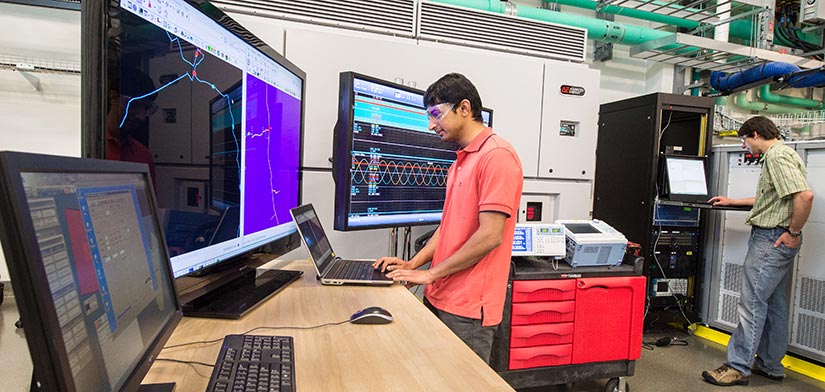Grid Simulation and Power Hardware-in-the-Loop
NREL's megawatt-scale power hardware-in-the-loop (PHIL) capability allows researchers and manufacturers to test energy technologies at full power in real-time grid simulations to safely evaluate performance and reliability.

A grid simulator is a programmable AC power supply capable of emulating varying grid conditions to facilitate the testing of grid-connected equipment. NREL operates two megawatt-scale grid simulators: a 1.08-MVA grid simulator in the Energy Systems Integration Facility and a 7-MVA grid simulator at the National Wind Technology Center called the controllable grid interface.
Hardware-in-the-loop simulation seamlessly integrates physical hardware and software models in a single closed-loop simulation, and PHIL does this at full power. By using software to simulate the actual electric distribution circuit, PHIL testing ensures new, innovative hardware works with the utility system at actual load levels before it is integrated in the system. Researchers can mirror real-world conditions and evaluate complex interconnection scenarios in a controlled laboratory setting—posing no risk to electric utilities or their customers.
Capabilities
- Development of real-time power device and network software models
- Interfacing and testing of megawatt-scale power hardware with real-time simulations
- Real-time power simulations across a range of timescales, from sub-cycle electromagnetic transients to quasi-steady-state power flow simulations
- Co-simulation involving hardware and software subsystems across multiple physical locations
- Inclusion of real-time models from other domains, such as communication networks and building and thermal systems, in PHIL simulations via co-simulation
Projects
This project evaluated battery energy storage system performance and validated holistic photovoltaics (PV)-battery energy storage inverter control applied across an electric distribution system. Individual inverter efficiency, battery utilization, and control response performance while operating in four key operational modes were evaluated. Then the system-wide impacts of controlling hundreds of distributed PV/storage units in four key operational modes were examined using PHIL. Detailed, real-time models of a complete electric distribution network under different loading scenarios and with varying penetrations of PV-only and PV-energy storage units were combined with a physical PV/battery inverter in a single closed-loop simulation.
The project demonstrated that coordinated control of many distributed PV-battery inverter units can provide valuable grid services, including voltage smoothing, reduced tap change operations of utility voltage regulators (and thus reduced operations and maintenance costs), and reduced peak distribution system power requirements.
NREL researchers also developed a PHIL system for testing inverter anti-islanding controls (which prevent inverters from unintentionally energizing a grid during an outage) in multiple-inverter scenarios. A suite of real-time PHIL models was developed to represent different interconnecting circuits between the inverters and different configurations of load within the island. The loads were tuned to closely match the real and reactive power of the inverters and to resonate at 60 Hz, intentionally creating a difficult situation for the inverters to detect. The inverters were tested for anti-islanding using a variety of interconnecting circuits designed to represent the range of possible configurations seen on the grid. In addition, anti-islanding tests were run with the inverters programmed for a variety of grid support functions.
Although the study did not investigate every possible island scenario, the scenarios that were tested experienced no islands longer than 700 milliseconds—well within the 2-second limit imposed by IEEE Standard 1547.
Publications
Experimental Evaluation of PV Inverter Anti-Islanding with Grid Support Functions in Multi-Inverter Island Scenarios, NREL Technical Report (2016)
In this study, PHIL-based testing was used to evaluate autonomous volt-VAR operations of multiple smart PV inverters connected to a real-time model of the IEEE 13-node test feeder. The results show that, depending on volt-VAR control parameters and grid parameters, interaction between inverters and between the inverter and the grid is possible—in some extreme cases with very high volt-VAR control slopes, fast response times, and large volt-VAR control response delays.
Publications
Power Hardware-in-the-Loop Testing of Multiple Photovoltaic Inverters' Volt-VAR Control with Real-Time Grid Model, Innovative Smart Grid Technologies Conference (2016)
Share
Last Updated March 17, 2025

